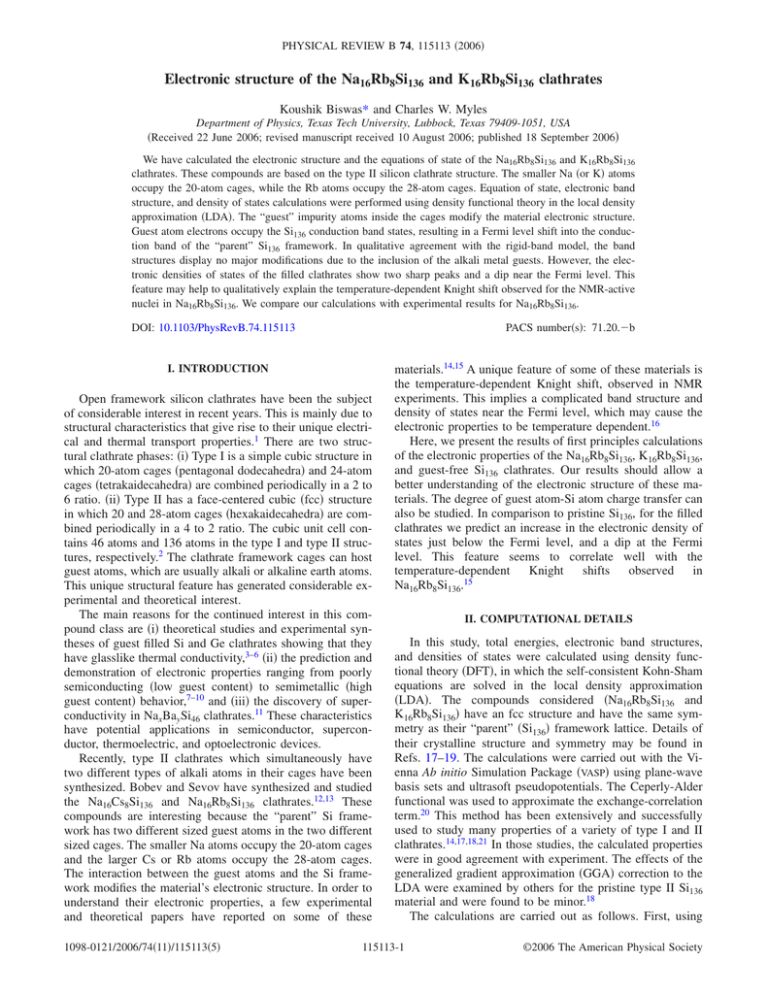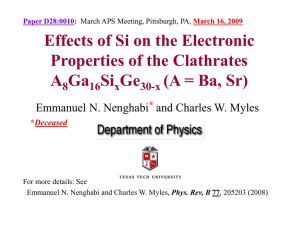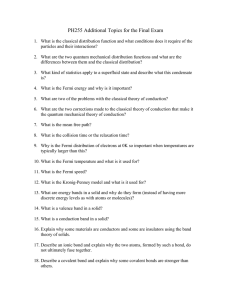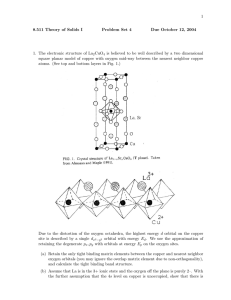Electronic structure of the Na Rb Si and K
advertisement

PHYSICAL REVIEW B 74, 115113 共2006兲 Electronic structure of the Na16Rb8Si136 and K16Rb8Si136 clathrates Koushik Biswas* and Charles W. Myles Department of Physics, Texas Tech University, Lubbock, Texas 79409-1051, USA 共Received 22 June 2006; revised manuscript received 10 August 2006; published 18 September 2006兲 We have calculated the electronic structure and the equations of state of the Na16Rb8Si136 and K16Rb8Si136 clathrates. These compounds are based on the type II silicon clathrate structure. The smaller Na 共or K兲 atoms occupy the 20-atom cages, while the Rb atoms occupy the 28-atom cages. Equation of state, electronic band structure, and density of states calculations were performed using density functional theory in the local density approximation 共LDA兲. The “guest” impurity atoms inside the cages modify the material electronic structure. Guest atom electrons occupy the Si136 conduction band states, resulting in a Fermi level shift into the conduction band of the “parent” Si136 framework. In qualitative agreement with the rigid-band model, the band structures display no major modifications due to the inclusion of the alkali metal guests. However, the electronic densities of states of the filled clathrates show two sharp peaks and a dip near the Fermi level. This feature may help to qualitatively explain the temperature-dependent Knight shift observed for the NMR-active nuclei in Na16Rb8Si136. We compare our calculations with experimental results for Na16Rb8Si136. DOI: 10.1103/PhysRevB.74.115113 PACS number共s兲: 71.20.⫺b I. INTRODUCTION Open framework silicon clathrates have been the subject of considerable interest in recent years. This is mainly due to structural characteristics that give rise to their unique electrical and thermal transport properties.1 There are two structural clathrate phases: 共i兲 Type I is a simple cubic structure in which 20-atom cages 共pentagonal dodecahedra兲 and 24-atom cages 共tetrakaidecahedra兲 are combined periodically in a 2 to 6 ratio. 共ii兲 Type II has a face-centered cubic 共fcc兲 structure in which 20 and 28-atom cages 共hexakaidecahedra兲 are combined periodically in a 4 to 2 ratio. The cubic unit cell contains 46 atoms and 136 atoms in the type I and type II structures, respectively.2 The clathrate framework cages can host guest atoms, which are usually alkali or alkaline earth atoms. This unique structural feature has generated considerable experimental and theoretical interest. The main reasons for the continued interest in this compound class are 共i兲 theoretical studies and experimental syntheses of guest filled Si and Ge clathrates showing that they have glasslike thermal conductivity,3–6 共ii兲 the prediction and demonstration of electronic properties ranging from poorly semiconducting 共low guest content兲 to semimetallic 共high guest content兲 behavior,7–10 and 共iii兲 the discovery of superconductivity in NaxBaySi46 clathrates.11 These characteristics have potential applications in semiconductor, superconductor, thermoelectric, and optoelectronic devices. Recently, type II clathrates which simultaneously have two different types of alkali atoms in their cages have been synthesized. Bobev and Sevov have synthesized and studied the Na16Cs8Si136 and Na16Rb8Si136 clathrates.12,13 These compounds are interesting because the “parent” Si framework has two different sized guest atoms in the two different sized cages. The smaller Na atoms occupy the 20-atom cages and the larger Cs or Rb atoms occupy the 28-atom cages. The interaction between the guest atoms and the Si framework modifies the material’s electronic structure. In order to understand their electronic properties, a few experimental and theoretical papers have reported on some of these 1098-0121/2006/74共11兲/115113共5兲 materials.14,15 A unique feature of some of these materials is the temperature-dependent Knight shift, observed in NMR experiments. This implies a complicated band structure and density of states near the Fermi level, which may cause the electronic properties to be temperature dependent.16 Here, we present the results of first principles calculations of the electronic properties of the Na16Rb8Si136, K16Rb8Si136, and guest-free Si136 clathrates. Our results should allow a better understanding of the electronic structure of these materials. The degree of guest atom-Si atom charge transfer can also be studied. In comparison to pristine Si136, for the filled clathrates we predict an increase in the electronic density of states just below the Fermi level, and a dip at the Fermi level. This feature seems to correlate well with the temperature-dependent Knight shifts observed in Na16Rb8Si136.15 II. COMPUTATIONAL DETAILS In this study, total energies, electronic band structures, and densities of states were calculated using density functional theory 共DFT兲, in which the self-consistent Kohn-Sham equations are solved in the local density approximation 共LDA兲. The compounds considered 共Na16Rb8Si136 and K16Rb8Si136兲 have an fcc structure and have the same symmetry as their “parent” 共Si136兲 framework lattice. Details of their crystalline structure and symmetry may be found in Refs. 17–19. The calculations were carried out with the Vienna Ab initio Simulation Package 共VASP兲 using plane-wave basis sets and ultrasoft pseudopotentials. The Ceperly-Alder functional was used to approximate the exchange-correlation term.20 This method has been extensively and successfully used to study many properties of a variety of type I and II clathrates.14,17,18,21 In those studies, the calculated properties were in good agreement with experiment. The effects of the generalized gradient approximation 共GGA兲 correction to the LDA were examined by others for the pristine type II Si136 material and were found to be minor.18 The calculations are carried out as follows. First, using 115113-1 ©2006 The American Physical Society PHYSICAL REVIEW B 74, 115113 共2006兲 KOUSHIK BISWAS AND CHARLES W. MYLES TABLE I. Birch-Murnaghan equation of state parameters 共T = 0 K兲 obtained from a fit of the LDA energy vs volume curve and the total binding energy per fcc unit cell for Na16Rb8Si136, K16Rb8Si136, and Si136. Also listed are the available experimental parameters for Si136 obtained at T = 298 K 共Refs. 25 and 26兲. Clathrate E0 共eV/atom兲 V0 共Å3 / atom兲 K 共GPa兲 K⬘ −5.34 −5.33 −5.87 - 19.59 19.78 22.71 23.01 81.88 86.17 83.23 90 1.79 0.51 3.58 5.2 Na16Rb8Si136 K16Rb8Si136 Si136 Expt. Si136 VASP, we optimize the geometry of each compound by choosing a fixed lattice constant and relaxing the internal coordinates through a conjugate gradient algorithm using atomic forces. The process is repeated for several different lattice constants until the global minimum energy is found. Brillouin zone integrations were performed using a 4 ⫻ 4 ⫻ 4 Monkhorst-Pack k-point grid.22 Once the equilibrium lattice geometry is obtained for each material, the resulting LDA energy versus volume curve is fit with the BirchMurnaghan equation of state 共EOS兲.23 This fitting determines the minimum binding energy E0, the corresponding volume V0, the equilibrium bulk modulus K, and its pressure derivative K⬘ = dK / dP. Then, using VASP, the electronic band structures and densities of states are calculated for the optimized geometry by generating a separate set of k points along certain high symmetry directions in the Brillouin zone. III. RESULTS AND DISCUSSION The total LDA energies at various volumes were fitted to the Birch-Murnaghan equation of state, as just described.24 The results for the fitting parameters E0, V0, K, K⬘, and the total binding energy per fcc unit cell are listed in Table I for Si136, Na16Rb8Si136, and K16Rb8Si136. Experimental values of some of the parameters for Si136 are also listed.25,26 As expected, the predicted total binding energy per fcc unit cell for the filled clathrates is higher than that for the guest free Si136. Table II shows the calculated and experimental values of the lattice constants for Si136 and Na16Rb8Si136 共Refs. 2 and 15兲 and also the calculated value for K16Rb8Si136. These are in excellent agreement with experiment. The equilibrium volume for Na16Rb8Si136 gives a cubic lattice constant of 14.63 Å, about 0.7% smaller than the experimental value of 14.738 Å. The electronic band structure and density of states 共DOS兲 calculations were done for the clathrates at their optimized TABLE II. Calculated and experimental values of the lattice constants for Na16Rb8Si136, K16Rb8Si136, and Si136 clathrates 共Refs. 2 and 15兲. Clathrate Na16Rb8Si136 K16Rb8Si136 Si136 Calculated 共Å兲 Experiment 共Å兲 14.63 14.64 14.56 14.738 14.626 Total energy/fcc unit cell 共eV兲 −213.56 −213.50 −199.73 geometries. It is well known that the LDA underestimates the minimum energy band gaps. However, it has been shown to predict energy differences and trends correctly, so a comparison of the band gaps between clathrates should be meaningful.27 Figures 1共a兲–1共c兲 show the predicted electronic band structures for the three materials. To enable an easy qualitative comparison, for each material we have chosen the zero of energy at the top of the valence band. The pristine material, Si136, has a predicted indirect band gap of about 1.24 eV, in agreement with LDA results obtained by others.18,28 The results for Na16Rb8Si136 and K16Rb8Si136 are nearly identical to those of the parent Si136 clathrate. For the filled clathrates, there is a “pseudogap” between the top of the valence band and the bottom of the conduction band at the L point. For Na16Rb8Si136, this is found to be approximately 0.75 eV or about 0.5 eV smaller than the LDA gap found for Si136. The results also show that the pseudogap for K16Rb8Si136 stays nearly the same as the bandgap of Si136. For this material, we also predict an overall decrease in the gap between the conduction and valence bands at various Brillouin zone points. Since all host framework bonds are satisfied by the Si valence electrons, electrons from the guests occupy the conduction states of the parent Si136. The Fermi levels for the filled clathrates lie within the Si136 conduction band, as shown in Figs. 1共b兲 and 1共c兲. Our results agree qualitatively with the “rigid-band model,”14,29 which predicts that the bands for the guest-containing materials are nearly the same as those of the framework and that there is a charge transfer from the guests into the host conduction states. This raises the Fermi level into the conduction band. The band structure results for Na16Rb8Si136 are consistent with the metallic behavior reported for that material by Latturner et al.15 Figure 2 shows the predicted electronic densities of states 共DOS兲 for Si136, K16Rb8Si136, and Na16Rb8Si136. The DOS distribution near the Fermi level of the filled clathrates shows a charge transfer from the Na 共or K兲 and Rb atoms to the Si framework. The DOS near the Fermi level is higher for the filled clathrates, because the guest atoms donate electrons to the Si framework. This increase might be associated with the low-temperature metallic behavior observed in Na16Rb8Si136.15 Comparison of the DOS for the three materials shows that there is a dip in the DOS near the Fermi levels of K16Rb8Si136 and Na16Rb8Si136. Such a dip was not found in theoretical studies of some other filled type II clathrates such as Cs8Ge136.30 115113-2 PHYSICAL REVIEW B 74, 115113 共2006兲 ELECTRONIC STRUCTURE OF THE Na16Rb8Si136¼ FIG. 2. Electronic density of states of Si136, K16Rb8Si136, and Na16Rb8Si136 in the valence band and the lower portion of the conduction band. The Fermi levels of K16Rb8Si136 and Na16Rb8Si136 are shown by a vertical line. FIG. 1. Electronic band structure of 共a兲 Si136, 共b兲 K16Rb8Si136, and 共c兲 Na16Rb8Si136. In all figures, the top of the valence band is the zero of energy. In 共b兲 and 共c兲, the Fermi level is pushed into the conduction band as shown by a dashed line at ⬇1.6 and 1.4 eV, respectively. Large Knight shifts have been observed in NMR experiments in the Na16Rb8Si136 and Na16Cs8Si136 clathrates.15,31 The alkali metal atoms in both materials are NMR active. In these type II clathrates, the Knight shifts for 23Na, 87Rb, 133 Cs, and 29Si each increase with decreasing temperature. This strong temperature dependence is very different from the Knight shift observed in metals, where it is approximately temperature independent.32 The temperaturedependent Knight shift observed in some of the clathrates may be attributable to two factors: a temperature dependent conduction electron spin contribution to the Pauli paramagnetic susceptibility p and a temperature-dependent contribution from the magnitude of the s-component wave function at the nucleus 关兩s共0兲 兩 兴.33 As originally proposed by Gryko et al.,16 contributions from these two sources may be related to a structural feature of the electronic DOS, which is not generally seen in metals. This consists of sharp peaks near the Fermi level 共E f 兲, separated by an energy difference, ⌬E. As is shown in Fig. 3, our results are consistent with this description. They clearly show two narrow peaks, separated by a ⌬E near the Fermi level in both Na16Rb8Si136 and K16Rb8Si136. This “dip splitting” in the conduction band of these filled clathrates is probably because the electronic wave functions of the conduction band states of the framework material are not greatly affected by the presence of the guest atoms inside the cages. However, the energy spacings of these bands are considerably affected near the Fermi level, leading to the two-peaked structure of the DOS, as seen in Fig. 3. This sharp dip in the DOS near the E f of the filled clathrates may provide a qualitative explanation for the observed large temperaturedependent Knight shifts. Figure 4 shows the s and p-orbital projected density of states 共p-DOS兲 of the three alkali atoms, the Na and the K located in the 20-atom cage, and the Rb inside the 28-atom cage. It clearly shows the s-orbital character of the states 115113-3 PHYSICAL REVIEW B 74, 115113 共2006兲 KOUSHIK BISWAS AND CHARLES W. MYLES FIG. 3. Comparison of density of states of Si136, Na16Rb8Si136, and K16Rb8Si136 in the lower portion of the conduction band. Fermi levels for Na16Rb8Si136 and K16Rb8Si136 are shown as E f,Na and E f,K, respectively. The latter two show a dip in DOS near the Fermi level. near E f . Judging from the p-DOS of the three alkali metals, we predict that the lower of the two peaks near the Fermi level in Fig. 3 will be similar to an impurity derived donorlike band. If the separation between these two peaks 共⌬E兲 is approximately in the range of kBT at the experimental temperatures, then this model might help us understand the temperature dependence of the Knight shift observed in these clathrates. At high temperatures, thermal excitation could promote electrons from the narrow alkali states to the p-like framework states. This thermal promotion across the “dip” of the two-peaked structure in the DOS will generally lead to an Arrhenius-like behavior of the susceptibility and Knight shift at higher temperatures. At low temperatures, however, the electrons are more likely to be found in the s-like donor bands. As the electrons become more confined to the lowlying donor bands at low temperatures, the magnitude of the s-component wave function at the nucleus 关兩s共0兲 兩 兴 increases, resulting in an increase in the Knight shift.33 The relatively high, narrow peaks of the DOS also mean a complicated electronic distribution, which may vary with changing temperature. Hence, a variation in p, which also depends on the electronic configuration near the Fermi level, is also expected to have a temperature variation. IV. CONCLUSIONS We have used the LDA to study the equations of state and the electronic structures of the type II clathrate materials Si136, Na16Rb8Si136, and K16Rb8Si136. Our results are consistent with the rigid-band model. The band structure of *Electronic address: koushik.biswas@ttu.edu 1 G. S. Nolas, G. A. Slack, and S. B. Schujman, in Semiconductors and Semimetals, edited by T. M. Tritt 共Academic Press, San Diego, 2001兲, Vol. 69, p. 255, and references therein. 2 J. S. Kasper, P. Hagenmuller, M. Pouchard, and C. Cros, Science 150, 1713 共1965兲. 3 G. A. Slack, in Solid State Physics, edited by F. Seitz, D. Turn- FIG. 4. s 共solid line兲 and p-orbital 共dashed line兲 projected density of states for 共a兲 Na, 共b兲 K, and 共c兲 Rb in the lower portion of the conduction band near the Fermi level. Na16Rb8Si136, with a predicted LDA “pseudogap” of 0.75 eV, is in qualitative agreement with the observed metallic behavior of this material at low temperatures.15 The densities of states show a dip near the Fermi level. Furthermore, the p-DOS of the three alkali metals show the s-orbital character of the states near E f . For the filled clathrates, this is consistent with the temperature-dependent Knight shift observed in NMR of some of these materials. Unlike metals, which have a broad, featureless DOS at the Fermi level, we predict that these filled clathrates should have a highly structured DOS in that region, which causes the observed temperature dependent change in the electronic configuration and provides a qualitative explanation for the temperaturedependent Knight shift. ACKNOWLEDGMENTS We thank O. F. Sankey 共Arizona State University兲, J. J. Dong 共Auburn University兲, and Mahdi Sanati 共Texas Tech University兲 for helpful discussions on the use of VASP for the LDA calculations. We thank G. S. Nolas 共University of South Florida兲 for helpful discussions on current experimental trends in type I and II clathrate materials. We also thank Emmanuel Nenghabi and Kenneth W. Carrell 共Texas Tech University兲 for helpful discussions. bull, and H. Ehrenreich 共Academic, New York, 1979兲, Vol. 34. A. Slack, in CRC Handbook of Thermoelectrics, edited by D. M. Rowe 共CRC Press, Boca Raton, FL, 1995兲, p. 407. 5 G. S. Nolas, J. L. Cohn, G. A. Slack, and S. B. Schujman, Appl. Phys. Lett. 73, 178 共1998兲. 6 J. L. Cohn, G. S. Nolas, V. Fessatidis, T. H. Metcalf, and G. A. Slack, Phys. Rev. Lett. 82, 779 共1999兲. 4 G. 115113-4 PHYSICAL REVIEW B 74, 115113 共2006兲 ELECTRONIC STRUCTURE OF THE Na16Rb8Si136¼ F. Mott, J. Solid State Chem. 6, 348 共1973兲. C. Cros and J. C. Bénéjat, Bull. Soc. Chim. Fr. 5, 1739 共1972兲. 9 A. A. Demkov, O. F. Sankey, K. E. Schmidt, G. B. Adams, and M. O’Keeffe, Phys. Rev. B 50, 17001 共1994兲. 10 V. I. Smelyansky and J. S. Tse, Chem. Phys. Lett. 264, 459 共1997兲. 11 H. Kawaji, H. O. Horie, S. Yamanaka, and M. Ishikawa, Phys. Rev. Lett. 74, 1427 共1995兲. 12 S. Bobev and S. C. Sevov, J. Am. Chem. Soc. 121, 3795 共1999兲. 13 S. Bobev and S. C. Sevov, J. Solid State Chem. 152, 92 共2000兲. 14 G. K. Ramachandran, J. Dong, O. F. Sankey, and P. F. McMillan, Phys. Rev. B 63, 033102 共2000兲. 15 S. Latturner, B. B. Iversen, J. Sepa, V. Srdanov, and G. Stucky, Phys. Rev. B 63, 125403 共2001兲. 16 J. Gryko, P. F. McMillan, R. F. Marzke, A. P. Dodokin, A. A. Demkov, and O. F. Sankey, Phys. Rev. B 57, 4172 共1998兲. 17 G. S. Nolas, C. A. Kendziora, J. Gryko, J. J. Dong, C. W. Myles, A. Poddar, and O. F. Sankey, J. Appl. Phys. 92, 7225 共2002兲. 18 J. Dong, O. F. Sankey, and G. Kern, Phys. Rev. B 60, 950 共1999兲. 19 J. Dong and O. F. Sankey, J. Phys.: Condens. Matter 11, 6129 共1999兲. 20 D. M. Ceperley and B. J. Alder, Phys. Rev. Lett. 45, 566 共1980兲. 21 C. W. Myles, J. Dong, and O. F. Sankey, Phys. Status Solidi B 239, 26 共2003兲. 22 H. J. Monkhorst and J. D. Pack, Phys. Rev. B 13, 5188 共1976兲. 23 F. Birch, J. Geophys. Res. 57, 227 共1952兲. 2 V0 2/3 9 24 The Birch-Murnaghan EOS is E共V兲 = E0 + 8 KV0关共 V 兲 − 1兴 兵1 2/3 V 4−K 0 + 共 2 ⬘ 兲关1 − 共 V 兲 兴其, where E and E0 are the energy and the minimum energy, V and V0 are the volume and the volume at the 7 N. 8 minimum energy, K and K⬘ are the bulk modulus and its pressure derivative. 25 A. San-Miguel, P. Kéghélian, X. Blase, P. Mélinon, A. Perez, J. P. Itié, A. Polian, E. Reny, C. Cros, and M. Pouchard, Phys. Rev. Lett. 83, 5290 共1999兲. 26 G. K. Ramachandran, P. F. McMillan, S. K. Deb, M. Somayazulu, J. Gryko, J. Dong, and O. F. Sankey, J. Phys.: Condens. Matter 12, 4013 共2000兲. 27 Using the GW quasiparticle approach it has been shown that the band gap for Si136 opens up to 1.9 eV. P. Mélinon, P. Kéghélian, X. Blase, J. Le Brusc, A. Perez, E. Reny, C. Cros, and M. Pouchard, Phys. Rev. B 58, 12590 共1998兲. 28 G. B. Adams, M. O’Keeffe, A. A. Demkov, O. F. Sankey, and Y-M. Huang, Phys. Rev. B 49, 8048 共1994兲. 29 C. W. Myles, J. Dong, and O. F. Sankey, Phys. Rev. B 64, 165202 共2001兲. 30 J. Gryko, R. F. Marzke, G. A. Lamberton, Jr., T. M. Tritt, M. Beekman, and G. S. Nolas, Phys. Rev. B 71, 115208 共2005兲. 31 R. F. Marzke, G. S. Nolas, and J. Gryko, in Thermoelectric Materials 2001–Research and Applications, edited by G. S. Nolas, D. C. Johnson, and D. G. Mandrus, Mater. Res. Soc. Symp. Proc. No. 691 共Materials Research Society, Warrendale, 2002兲, p. 439. 32 G. C. Carter, L. H. Bennett, and D. J. Kahan, Metallic Shifts in NMR, Part I, Progress in Materials Science, Vol. 20 共Pergamon, Oxford, 1977兲. 8 33 The Knight shift is given by K = 3 p具兩s共0兲兩2典, where p is the Pauli paramagnetic susceptibility and 兩s共0兲兩 is the magnitude of the s component of the wave function at the nucleus. 115113-5


